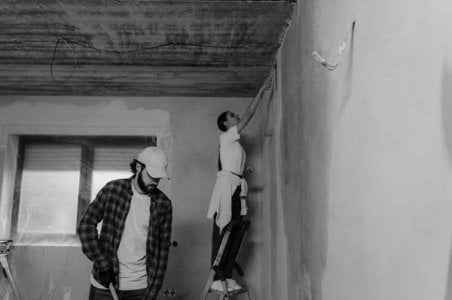Protect Your Family: Shocking Link Between Home Renovations and Deadly Mesothelioma Will Have You Demanding Change Instantly!
By
Danielle F.
- Replies 5
As we roll up our sleeves and dive into the world of home renovations, the dream of transforming an old house into a cosy, modern home is a common aspiration for many Australian families. However, lurking beneath the layers of paint and behind the walls of our beloved fixer-uppers lies a hidden danger that has already changed the lives of too many Australians: asbestos.
The tragic story of Kathleen Drage, who was exposed to asbestos while renovating a family beach house, is a stark reminder of the legacy this hazardous material has left behind. Twenty years after her exposure, Kathleen was diagnosed with mesothelioma, an aggressive cancer caused exclusively by asbestos. Her husband, Mark, and their family endured a gruelling journey through treatments before Kathleen's passing in 2023.
But Kathleen's story is not an isolated one. Across the country, families are grappling with the devastating consequences of asbestos exposure. Jarni Greatorex, an 18-year-old, represents a heartbreaking case of the youngest Australians currently battling mesothelioma. Her life, which should have been filled with the milestones of youth, has instead been consumed by hospital visits and intense treatments.
These personal tragedies have sparked a nationwide call to action. Advocates like Mark Drage and support groups are urging homeowners to employ professionals for the safe removal of asbestos, to prevent further suffering. The dangers of DIY renovations on older homes, which may still contain asbestos, cannot be overstressed. Asbestos-related diseases claim over 4,000 Australian lives each year, and the numbers are growing among those who encounter asbestos outside of occupational settings.
The presence of asbestos in an estimated one-third of Australian homes is a ticking time bomb. The Asbestos and Silica Safety and Eradication Council (ASSEA) is pushing for mandatory disclosures to potential buyers and renters of old houses. Their national plan also proposes incentives for homeowners to conduct asbestos inspections and surveys.
Barry Robson, a former Sydney wharfie and union leader, is among those advocating for a register on every house built before 1990, requiring an asbestos inspection certificate before sale. This proposal, however, is met with caution by the real estate industry. While the Real Estate Institute of Australia (REIA) president Leanne Pilkington acknowledges the need for transparency, she emphasises that 'bonded' asbestos products are considered low risk unless damaged or deteriorated.
The debate extends to the '10 square metre' rule, which currently allows homeowners to dispose of a small quantity of bonded asbestos without a license—a rule that campaigners like Robson want abolished.
The dangers of improper asbestos disposal are not to be underestimated. Sean Lamprecht, who runs a demolition business specialising in asbestos removal, witnesses the complacency and naivety of those who underestimate the risks. He, along with many professionals, advises against DIY asbestos removal, emphasising the importance of proper training and professional services.
The stories of Kathleen and Jarni are a clarion call for change. It's time for a collective outcry for more awareness, stricter regulations, and proactive measures to protect current and future generations from the deadly legacy of asbestos. As we consider the dream of renovating our homes, let's not forget the potential cost. It's not just about the aesthetics; it's about the health and safety of our families.
We at the Seniors Discount Club urge you to take this issue seriously. If you're planning renovations, get your home checked for asbestos. If you're buying or renting an older property, ask about its asbestos status. It's a small step that could save lives.

Have you or someone you know been affected by asbestos during home renovations? Share your experiences and thoughts on how we can better protect our families from this hidden danger. Your voice could be the catalyst for the change we desperately need.
The tragic story of Kathleen Drage, who was exposed to asbestos while renovating a family beach house, is a stark reminder of the legacy this hazardous material has left behind. Twenty years after her exposure, Kathleen was diagnosed with mesothelioma, an aggressive cancer caused exclusively by asbestos. Her husband, Mark, and their family endured a gruelling journey through treatments before Kathleen's passing in 2023.
But Kathleen's story is not an isolated one. Across the country, families are grappling with the devastating consequences of asbestos exposure. Jarni Greatorex, an 18-year-old, represents a heartbreaking case of the youngest Australians currently battling mesothelioma. Her life, which should have been filled with the milestones of youth, has instead been consumed by hospital visits and intense treatments.
These personal tragedies have sparked a nationwide call to action. Advocates like Mark Drage and support groups are urging homeowners to employ professionals for the safe removal of asbestos, to prevent further suffering. The dangers of DIY renovations on older homes, which may still contain asbestos, cannot be overstressed. Asbestos-related diseases claim over 4,000 Australian lives each year, and the numbers are growing among those who encounter asbestos outside of occupational settings.
The presence of asbestos in an estimated one-third of Australian homes is a ticking time bomb. The Asbestos and Silica Safety and Eradication Council (ASSEA) is pushing for mandatory disclosures to potential buyers and renters of old houses. Their national plan also proposes incentives for homeowners to conduct asbestos inspections and surveys.
Barry Robson, a former Sydney wharfie and union leader, is among those advocating for a register on every house built before 1990, requiring an asbestos inspection certificate before sale. This proposal, however, is met with caution by the real estate industry. While the Real Estate Institute of Australia (REIA) president Leanne Pilkington acknowledges the need for transparency, she emphasises that 'bonded' asbestos products are considered low risk unless damaged or deteriorated.
The debate extends to the '10 square metre' rule, which currently allows homeowners to dispose of a small quantity of bonded asbestos without a license—a rule that campaigners like Robson want abolished.
The dangers of improper asbestos disposal are not to be underestimated. Sean Lamprecht, who runs a demolition business specialising in asbestos removal, witnesses the complacency and naivety of those who underestimate the risks. He, along with many professionals, advises against DIY asbestos removal, emphasising the importance of proper training and professional services.
The stories of Kathleen and Jarni are a clarion call for change. It's time for a collective outcry for more awareness, stricter regulations, and proactive measures to protect current and future generations from the deadly legacy of asbestos. As we consider the dream of renovating our homes, let's not forget the potential cost. It's not just about the aesthetics; it's about the health and safety of our families.
We at the Seniors Discount Club urge you to take this issue seriously. If you're planning renovations, get your home checked for asbestos. If you're buying or renting an older property, ask about its asbestos status. It's a small step that could save lives.
Key Takeaways
- Kathleen Drage was exposed to asbestos while renovating a family beach house and was diagnosed with mesothelioma 20 years later, leading to her death in 2023.
- Mark Drage and others are advocating for increased awareness about the dangers of asbestos, particularly in home renovations, to prevent further tragedies like Kathleen's.
- Asbestos is still present in an estimated one third of Australian homes, prompting calls for mandatory disclosures to buyers and renters, and incentives for safe removal.
- Industry experts and asbestos removal advocates are pushing for regulatory changes and advise against DIY removal, emphasising the importance of professional handling to avoid health risks.








